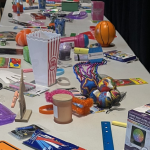In The Leadership Challenge, 6th Edition, the story of Steve Skarke (pgs. 71 – 72) highlights how one leader set a personal example of what he expected for his organization. We suggest the following activity for facilitating with the team you lead or the team you are on:
Activity for Team Meeting or Personal Reflection:
Have each meeting participant review the Steve Skarke story. Talk through the story using the following questions:
- What do you think it means to set a personal example?
- How does Steve Skarke set a personal example?
- Who in your life has set a personal example and how did it impact you?
- What will you do to set a personal example in the next 30 days?
THE STEVE SKARKE STORY
Kaneka Texas is a Specialty Polymer Manufacturing Company in Pasadena, Texas. In operation since 1984, the plant had been through several growth spurts when Steve Skarke suddenly found himself tapped to be the plant manager in 2002. Steve readily admits that he was unprepared for the job, but after a few years of “trial and error” leadership, he started honing in on his own style of leading which usually included some rather unorthodox ideas—at least for the mostly conservative crew at Kaneka.
For a few years, the manufacturing management team had been discussing the vision of becoming a “World Class Plant.” They debated the characteristics defining a world-class plant and agreed that a strong culture of safety and good housekeeping should be at the top of the list. Looking around Steve could clearly see that the housekeeping conditions at Kaneka did not meet the company’s shared vision. In fact, whenever they had a pending customer visit, Steve would have to remind everyone to make an extra effort to clean up. This included sending people out to pick up trash in the plant, on the roads, and in the parking lot. It was a disruption to daily activities. Steve knew there had to be a way to make cleanliness a part of their daily routine. It would take action not words.
One day while Steve was at lunch, he stopped into a hardware store and bought a two-gallon plastic bucket. He put the words “World Class Plant” on the side of the bucket. “That afternoon,” Steve said, “I walked through the plant and picked up as much trash as I could fit into my bucket, and it was overflowing. I then walked through the main control room with my bucket of trash, and, with everyone intently watching, emptied it into a trashcan and simply walked out the other door, saying nothing. Word spread that I was in the plant with a bucket picking up trash.”
Each time Steve ventured out with his bucket in hand he made sure that he would be seen. It didn’t take long for more buckets to appear. Other managers went out into the plant to pick up trash each day, setting the example for all to follow. Pretty soon when Steve walked through the control room, operators would ask how much trash he was able to find. If his bucket was full, he would walk by the supervisor’s office and hold it up for inspection. The process that Steve had started by his visible example soon became the norm.
“Over the course of the next few weeks or so,” Steve reported, “trash disappeared from the plant, and it was getting more difficult for me to put anything in my bucket. On ‘empty bucket days’ I would make a point to stop by the control room and thank the gang for their efforts. It became an inside joke with some of the operators.”
In addition to the actual trash removal, the activity started generating lots of discussion and new ideas about how they could make the job of cleaning the plant easier. Trash cans that were previously removed were back in key areas where collection would be easier. The operation staff agreed to maintain these cans and came up with more ideas to better organize their work areas. The maintenance technicians began carrying buckets around to keep parts and trash contained to make clean-up quicker and easier.
During this time, a new program called “My Machine” was also enacted where each operator was assigned a certain piece of equipment to clean, paint, and learn about its function to ensure proper operation.
“By simply deciding to venture out and start picking up trash,” Steve told us, “I was modeling the way by aligning my actions with the shared value of having a clean plant. It also helped me to ‘find my voice’ around this very important issue of housekeeping. I made it personal for everyone. In a short time, many others were setting the same example.”
“I don’t really remember how long it took,” Steve recalled, “but one day I decided to retire my bucket. I made it clear to everyone that the team had made a real cultural shift and that I would no longer give any advance warning of customer visits….I am proud of the team and what we accomplished, and I have been able to keep my promise of not asking for special attention in advance of visitors. I simply announce the visit and comment that ‘I know the plant is ready!’”
Six years later they are still working to improve housekeeping at Kaneka Texas; it is a never-ending battle, and one that fits their shared value of “Continuous Improvement.” The very simple action of one leader resulted in a huge cultural shift in the organization. Steve still has his bucket in his office as a reminder that setting the example works and that his job is never finished. “What is the next shared value that needs to be reinforced?” Steve asks. “What is the next process that needs to be challenged? What else should I put in my leadership bucket?”










